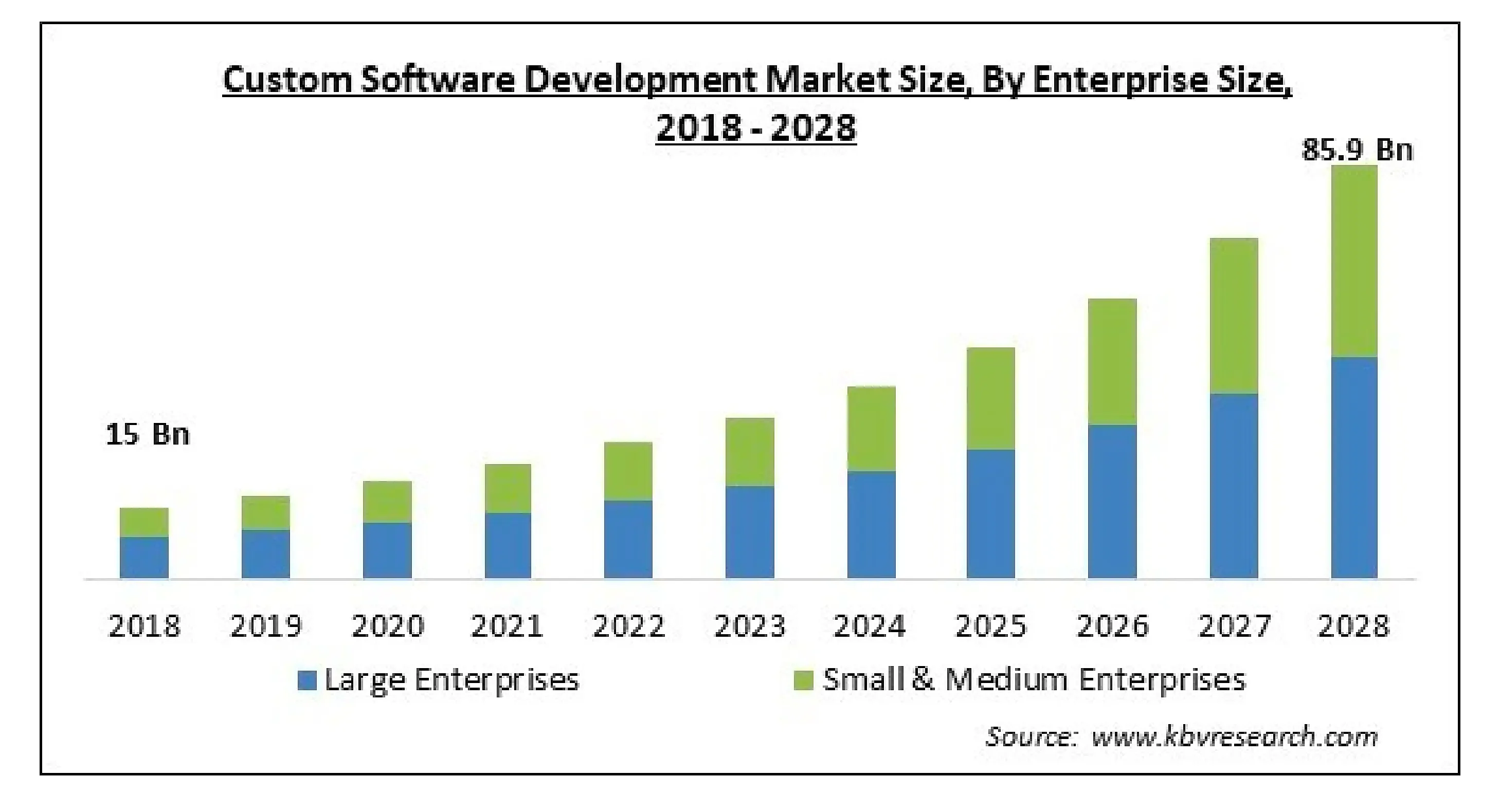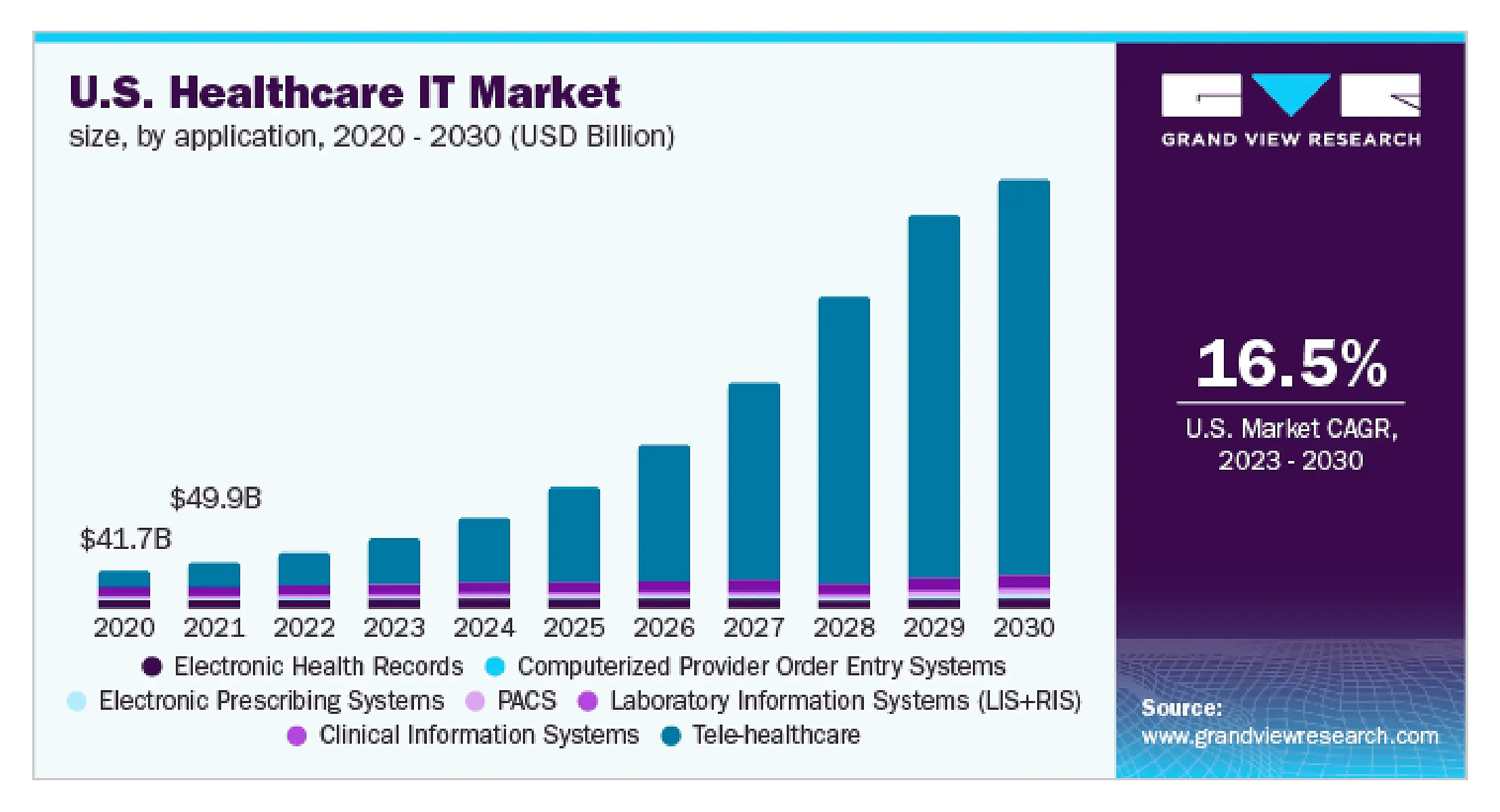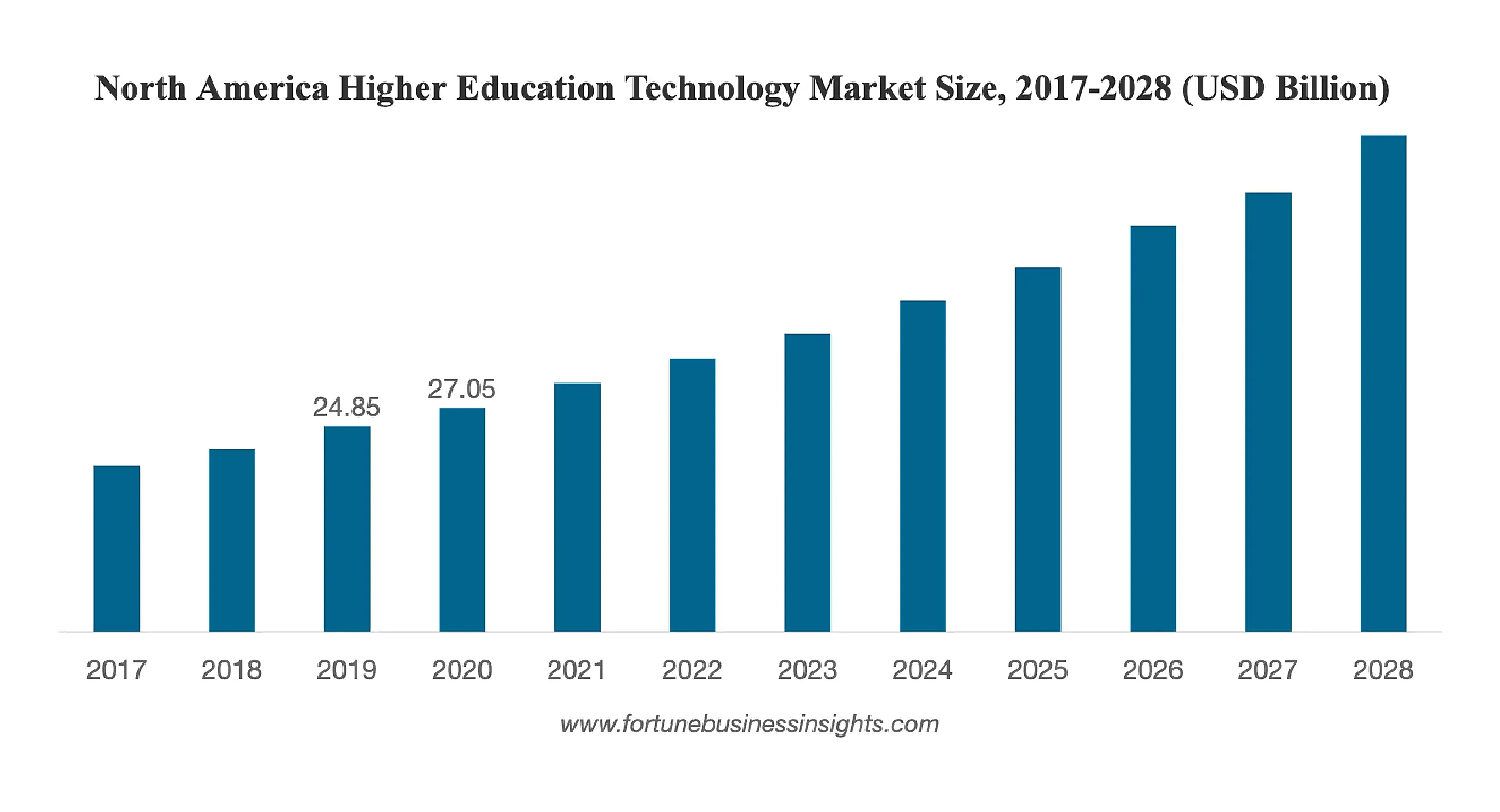
- What is Software Development? An Overview
- Software development: A Look Back to its Roots
- An Insight into the Software Development Industry
- Why is software development important?
- Key Features of Software Development
- Different types of software development
- How to Develop a Software? - The Software Development Process
- Tips for Effective Software Development
- Industries Benefiting from Custom Software Development
- Cost of developing custom software
- Final thoughts

Anyone not living under a rock is probably aware of the dynamic shift happening in the business world across the globe. Information Technology is taking over; whether you like it or not, it is here to stay. The unparalleled benefits and seamless operations provided by modern software and mobile applications are something the business world cannot overlook.
And evidently, companies are embracing digital transformation and the automation era to keep pace with the world and the dynamic needs of their consumers. Today, IT software is almost an indispensable part of modern business strategies and everyday operations. It enables businesses to get better and more efficient business processes and insight generation.
But do you really know what software development is? How does it work? Or how can it benefit you? Relax; we got your back!
This article aims to shed light on the question of “what is the Software development lifecycle and the significance of software development in the business world. We will analyze the software design process and development in detail, study the various types of software development, and get a detailed understanding of the software development basics and software development steps.
What is Software Development? An Overview

Let’s kick off with the question of what software development is? We’ve all seen a photo of a guy sitting in front of a computer with a sea of zeros and ones on the screen. Is that what software development means?
Simply put, software development means creating, designing, and maintaining software applications or programs that perform specific functions and meet user needs. Software development involves a series of tasks, like collecting requirements, planning, coding, testing, and deployment.
Software development is done using computer programming performed by a software developer. These developers, with the help of several programming languages and various tools. Build applications for web, mobile, desktop, or embedded systems platforms. The main purpose of this process is to create high-quality, efficient, and user-friendly software that solves a problem while automating processes.
Software development: A Look Back to its Roots
Software development, or computers in general, in fact, haven't been around for a long time. However, the jump that computer software development technology has made in the past few decades is something we have never seen before. Ever since Tom Kilburn, a British computer scientist, wrote the world’s very first piece of software in 1948, the advancements in IT have been mind-boggling.
However, many years after this groundbreaking event, computers were programmed with punch cards. In these punch cards, holes denoted specific machine code instructions that a computer performed. Furthermore, the size of computers at the start was exponential, and computers were only used by government and mega-scale companies for basic computation.
The image below shows IBM shipping a 5MB hard drive in 1956:

Cut to the late 1970s and early 1980s, computers hit the retail shelves after the introduction of personal computers and thus propelled the era of modern software development. Software development today has gone universal. Whether it is an on-demand pot-delivery mobile application or software protecting the nuclear codes, everything is done by leveraging the potential of software development. People, even in the most remote areas, can gather this knowledge and create applications to solve their own real-world problems.
An Insight into the Software Development Industry
The software development market has come a long way since the 90s. Technology has grown almost 2x in every 18 months since the 1970s, according to media Peanut. It signifies the exponential demand and growth the IT or any other sector has observed.
Also, talking about software development in particular. The growth the custom software development industry has experienced is also nothing short of astounding. The industry in 2018 observed a total market size of $15 Billion. However, this number is projected to skyrocket and cross the threshold of a whopping $85 billion by 2028, with a CAGR of 20.3%, according to KBV Research.

Why is software development important?
There is no question that in the future, the name of the game is IT. Like in warfare, the more advanced technology you have, the more chance you have of defeating your competitors. Why? Because technology is a force multiplier. Meaning technology allows people to get more work done in less time or automates certain tedious tasks that are often time-consuming and require loads of manual intervention.
Now that we have set the context, let’s look at some hard points to cement the importance of software design and development, especially in the 2023 business landscape.
1. Competitive Advantage
Staying ahead of the curve is a priority in today's highly competitive landscape. Customized software solutions aim to solve critical business bottlenecks and increase efficiency. Thus, being the first company in the industry to use a software solution can certainly give you the first-mover advantage. That’s how many companies initially enjoyed software applications in the olden days. However, automated software is everywhere now, so can these solutions give you the same results today?
In short, yes. However, every industry is using some type of modern IT software. It is notable to know that technology is ever-changing. So, keeping up with the latest technology allows you to catch up with your competitors or adapt to the changing demands of the consumers.
2. Enhancing Operational Efficiency
This was one of the primary reasons for conceptualizing software development basics in the first place. The manual process of tedious tasks was the norm in the olden days before software development came into play. Customized software solutions are designed and envisioned to automate these tiring tasks, eliminate manual errors, and optimize processes. This efficiency boost led to low errors, reduced costs, and improved resource allocation, contributing to better organizational performance.
3. Enables Global Connectivity
Software applications have connected the world in ways that were previously unimaginable. Anyone in one corner of the world can connect with someone from another with just a click of a button. Things that were in the realm of science fiction are now an everyday reality. Not only for businesses, communication tools and social media platforms have helped people bridge geographical gaps and enable people to stay connected always. This hyperconnectivity around the world further paved the way for cultural exchange, knowledge dissemination, and business expansion across borders.
4. Access to Better Mobility and Accessibility
Are you reading this article on your mobile device? Maybe a tablet? Well, you can thank software development for this convenience. Back in the 1900s, gathering insights or connecting with people was rather difficult when you were on the go. Also, the concept of working from home didn’t exist. Why? Because back then, people were confined to a limited space as there were no digital means to share information and data.
However, software development allowed people to share and receive data in the form of reports, images, text, and countless others through various portable devices. It enabled people to collaborate from different geographical locations and allowed seamless operations even when you’re on the road.
5. Data-Driven Decision-Making
Besides automating regular tasks and streamlining processes, software development helps in turning a big cornerstone. Software development allows us to collect data in a ridiculous amount, and with this, data emerged as the new gold. Now, companies can process and analyze this data to generate insights that give a clear picture of business so you can make decisions and create strategies driven by these insights.
Key Features of Software Development
Software development is a delicate yet essential process that should include an array of different features to create an excelling product capable of delivering exceptional results. You need to be proficient in the technologies and techniques to speed up software deployment, quality, and efficacy.
1. Effective User Experience (UX) and User Interface (UI) Design
Creating a user-friendly interface and a positive user experience contribute to the software's usability and adoption. UX and UI design focus on seamless navigation, aesthetics, and ease of interaction that could make the entire customer journey a delight.
2. AI/ML Integration
Integration of AI/ML technology is getting increasingly crucial in software development as the world has seen a gigantic propulsion of the technology within the span of 5 years. Artificial intelligence and machine learning can allow software to make intelligent decisions and generate insights based on data.
3. Agile Development Practices
Agile methodologies, such as Scrum or Kanban, emphasize iterative and incremental development, allowing for flexibility, faster releases, and continuous improvement based on user feedback.
Low code Approach: Low Code is yet another feature becoming increasingly important in the software development industry. As the name suggests, low code is a technique that reduces the coding requirements and allows non-coders, or citizen developers, to build applications quickly and easily.
4. Cloud-based Software Development
Most of the software, regardless of its nature, has shifted to a cloud-based model. And rightfully so, these models offer an exceptional level of backup and security. Moreover, compared to on-premises, cloud-based development offers businesses a chance to create software with lower costs and better resource management.
5. Flexibility and Scalability
Software should be designed to handle increased workloads as user demands grow. Also, it should be capable enough to adapt to future changes as technology matures. A good software development process ensures flexibility and scalability for optimizing performance and expanding resources to accommodate higher usage.
Different types of software development
Various types and technologies in software development are used to create chart-busting software design and development. These software types work on different functionality and are used for different objectives. Mentioned below are different types of software development and their uses.
1. Application development
It involves creating software that allows users to complete tasks. This could be anything from using office tools, media players, and social media apps to booking systems. These applications can work on your own computer or on remote servers, like those in the cloud or managed by your company's IT team.
2. Web Development
Another software development type is web development. You might see its results when you browse a website or surf the internet. As the name suggests, web development refers to software developing for websites. Web developers craft websites and applications using programming languages like HTML, CSS, and JavaScript. They are responsible for delivering seamless functionality, aesthetics, and user experience.
3. Embedded Systems Development
Software developing is not just for computer and mobile devices. Today, almost every digital device is connected to the internet in one way or another. This is done with the help of sensors and, yes, software. Embedded systems developers work on software that runs on devices like IoT devices, medical equipment, and automotive systems.
4. System software development
The primary purpose of system software development is more towards the technical side. Despite working on applications or web development, this development type focuses on the core functions of a system. System software development mainly works on creating operating systems, storage systems, databases, networks, and hardware management.
These were the basics of software development types. There are many other types of software development that It companies work on. These are some honorable mentions.
- Front-end development
- Back-end development
- Full-stack development
- Mobile application development
- Desktop development
- Security software development
- Game development
- Data Science
How to Develop a Software? - The Software Development Process
There are several steps of software development that every developer must consider during the software development process steps. Whether it is a software design process or coding, these steps are crucial to creating a user-friendly and bug-free product. Here are the software development steps businesses must follow to create compelling and refined products.
1. Requirement gathering and analysis
Before the software development phase, one of the first steps is understanding why the software is being designed. What is the intent behind the software, and what problem does this software need to solve? Thus, the first step of any software development process is gathering requirements.
Requirement steps in software development constitute several discussion and brainstorming sessions with the client to identify their key requirements, goals, functionalities, and pain areas. Moreover, recruitment gathering is not limited to just internal mediums. Market research and analysis related to the software is also essential to understand the viability of the software in the pipeline.
2. Creating architecture and design
In this phase, developers design the software's architecture and user interface. They create a blueprint that presents the journey of the user within the software. It also helps in clarifying how different components will interact within the software.
Furthermore, the DSD or design specification document specifies the product's architectural design, communication, user interface, and user flows. These phases of the software development steps essentially give a roadmap to the developers and reduce the chances of flaws and delays in the finished product.
3. Development and implementation
Now comes the core part of the software development process steps: developing the software and implementing the code. This is where traditional coders come into play. Arguably one of the most demanding steps in software development (Financially and otherwise), the developing stage involves writing the actual code based on the design specifications. Developers choose programming languages, frameworks, and tools to create the software's functionality. This step translates the design into executable code that the computer can understand and execute.
4. Software testing
Your software is developed at this phase, and the testing phase needs to begin. Software testers (manual and automated) take the software and check it for bugs and glitches that might occur. It verifies its performance before delivery and ensures the product is smooth, UI-friendly, and ready to go live for the users. Testing steps in software development act as a quality checkpoint for the software, trying to find any bumps and dents in the product.
5. Deployment and maintenance
Now that your product is tested, packed, and ready, the only thing left to do is deploy it to the customer or market. The deployment phase may involve installing the software on individual devices, making it available for download, or setting it up on a network for a larger audience.
Moreover, after the users have adopted the software, maintenance, and upgrades are the last but continuous processes to keep the software up and running. Regular maintenance and upgrades are essential as the software needs to go through changes to keep up with the latest technological advancements.
Tips for Effective Software Development
Developing software is not a piece of cake. It requires a vast knowledge base of IT programming languages, logic, and math. However, software development can still be challenging even after excelling at these mentioned components. Worry not; here are some tips that you can use to uplift your software development game.
1. Clearly Define Requirements
Knowing what you want out of the software is important to create the software itself. Understanding and documenting the project's requirements before starting development can eliminate almost half of the confusion and doubts. Clear instructions and goals prevent misunderstandings, scope creep, and last-minute changes.
2. Establish Clear Development Standards
Establishing a development standard helps you follow a clear carved-out path of development, eliminating chances of errors and duplicity of work. You can set development standards by emphasizing coding documentation and code review processes within these standards. This can help you better collaborate with your team members as all the communication is clear and documented.
3. Plan and Set Goals
Planning and strategizing is also an important aspect if you want to develop a good application within a short time frame. Create a comprehensive project plan with clear milestones, deadlines, and deliverables. Setting achievable goals helps keep the development process on track and ensures timely completion.
4. Choosing the Right Methodology
The methodology will define the flow of your development process. Thus, selecting the right methodology is crucial for optimized software, as each methodology has its strengths and weaknesses. Select an appropriate development methodology, such as Agile, Scrum, or Waterfall, based on the project's nature, requirements, and team dynamics.
5. Communication is Key
Maintain open and transparent communication among team members, stakeholders, and clients. Regular updates, meetings, and feedback sessions help everyone stay informed and aligned.
6. Prioritize User Experience (UX)
Probably one of the most noteworthy things in any software is its user experience. Keep in mind you are not creating the application or software for yourself; you are making it for your users. So, the user journey must be flawless and engaging. Thus, focusing on creating a seamless and intuitive user experience can go a long way. User-centered design ensures the software meets user needs and expectations, enhancing adoption and satisfaction.
Industries Benefiting from Custom Software Development
Almost every industry is reaping the benefits of software development nowadays. The technology offers every sector a chance to streamline tasks and enable better and faster decision-making. Here are some examples where software development is proving its worth.
1. Healthcare
The healthcare sector is a broad industry with many tangent sectors that work in unison to keep the health and well-being of people in check. In an industry where seconds matter, and split-second decisions are made, digital automation can be a great helping hand.
In healthcare, custom software can be utilized for electronic health records (EHR) management, patient scheduling, telemedicine platforms, medical billing, and diagnostic tools. It improves patient care and data security and streamlines administrative tasks. IT and software development are so paramount in healthcare that the healthcare IT market in the USA alone was $167.7 billion in 2022, with an estimated growth of around a CAGR of 17.9%.

2. Manufacturing and Logistics
In manufacturing and logistics, custom software applications are used to better manage supply chains, optimize production schedules, and monitor real-time equipment performance. These solutions empower manufacturers to make data-driven decisions and minimize their production downtime across production units. From factory automation to quality control, software development drives smoother operations and improved output in the production plant.
3. Finance and Banking
Finance and banking are the backbone of any economy, enabling the smooth flow of funds across the country and safeguarding the financial assets of literally everyone. However, with the increasing push for digitalization, problems like cyber security and regulatory compliance have become a pressing issue.
Custom software development allows institutions to tackle these challenges effectively. This is why, according to Gartner, banks and investment firms spend around $623 Billion on technology products and services in 2022. Financial institutions leverage the capabilities of several risk management, fraud detection, and regulatory compliance solutions that enhance security and provide tailored financial services.
4. Real Estate
Another industry where software and custom software development proves its worth is Real Estate. The real estate business is a dynamic one where buying and selling are the key to making money. While the sector has flourished, several challenges include a lack of transparency, complex transaction processes, and time-consuming paperwork.
Software development allows the sector to digitize all its manual processes and simplify the payment and documentation process. Moreover, technologies like VR and AI are also enabling regents to deliver a more personalized and convenient service to their clients. According to Encora, VR alone is estimated to generate more than $2 billion by 2025.
5. Education
Digitization and software development have also expanded their wings into the education sector. According to Fortune Business Insights, North America's higher education technology market size is projected to grow by more than $169 billion by 2028. An application or software can now handle many on-paper tasks like attendance recording. Also, with remote learning becoming an increasingly engaging concept, the education industry provides tailored applications for at-home teaching sessions to their students.
Custom software applications cater to individual learning styles, allowing educators to personalize lessons and engage students like never before. This has given rise to the idea of EdTech, which continues to be a rising market altogether. Learning management systems, interactive e-books, and virtual classrooms are some other examples of the impact of IT and software development on the industry.

Cost of developing custom software
We can go all day describing the great benefits of software development and its usefulness in the business world, but no matter how much you want to create your own software, business is run on numbers. Figuring out the budget cost of developing custom software is just as crucial as building the actual software.
You're probably aware of the extraordinary resources creating software, or a mobile application can demand from the business, especially if you're working with an in-house team. However, choosing the right software design process and finding the top custom software development companies can save lots of money bags.
Normally, a small to medium size software development can cost you around $50,000 to $100,000. However, this number varies for the type and scale of software you want to create.
Final thoughts
That was the brief software development introduction and an insight into how to create software programs. These technologies in software development basics allow you to develop robust software solutions capable of delivering exceptional results. software development is the backbone of our digital world, fostering innovation, efficiency, and progress across industries.
As technology continues to evolve, software development will certainly remain at the forefront of innovation, empowering businesses to adapt and thrive in the ever-changing business landscape.
Companies have already adopted software development capabilities into their businesses, and the race is just beginning. Top Custom Software Development Companies offer digital automation and personalized software solutions to their clients so that they don't have to ask how to create a software application. So, If you also want to start your automation journey, partnering with the best software development companies will be the way to go.

Sr. Content Strategist
Meet Manish Chandra Srivastava, the Strategic Content Architect & Marketing Guru who turns brands into legends. Armed with a Masters in Mass Communication (2015-17), Manish has dazzled giants like Collegedunia, Embibe, and Archies. His work is spotlighted on Hackernoon, Gamasutra, and Elearning Industry.
Beyond the writer’s block, Manish is often found distracted by movies, video games, AI, and other such nerdy stuff. But the point remains, If you need your brand to shine, Manish is who you need.












